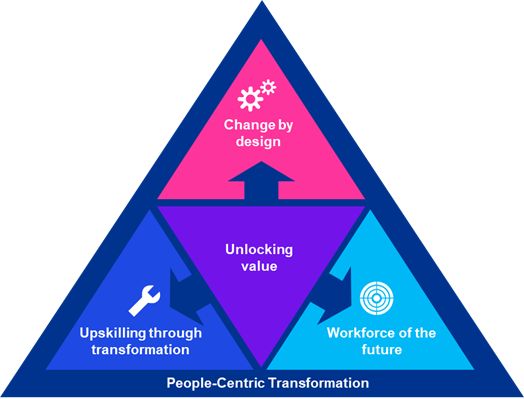Transformation is now a constant for organisations, but success remains elusive. Transformation efforts require reframing the entire business, not incremental changes, but a huge amount of energy, investment, and focus. Leaders may feel they are taking a personal risk, having to balance sustaining performance with the need to unlock future growth, it is tempting to retreat.
So, what do organisations need to do differently?
We have identified 5 golden rules to get transformation right – placing VALUE and PEOPLE at the heart of it to unlock lasting results:
- It must be Leader led – We know that transformation is a social and adaptive challenge not a technical one
- Set challenging and ambitious targets – Contract with your Board on value creation, and % cost reduction and a release of capacity across the business
- Take people on the journey – Your people will be the multiplier in achieving value
- Develop a value mindset – Looking at the portfolio through a value lens to prioritise and unlock benefits
- Build a lasting capability and change muscle – Enhancing the ability to respond, adapt and thrive
1. It must be Leader led
Too often the focus is on the technical solution. Transformation is seen as a rational challenge - if we get the technology and process right – we will be successful. We know that transformation is a SOCIAL and ADAPTIVE challenge not a TECHNICAL one. This means organisations cannot simply focus on implementation management. It needs to be leader led.
The quality of leadership will be the greatest predictor of Transformation success. Leaders will need to rebalance their priorities; spend up to 60% of their time engaging stakeholders and their people. Belief, desire, and conviction will make the difference. It is the emotional connection that compels people to think and act differently.
So, what are the opportunities for leaders to practice the behaviours needed?
We’ve found it’s about empathy, coaching and curiosity. Not all leaders will be natural transformational leaders, and they may need support along the way.
At KPMG, we use ‘Ignition’ hubs as collaborative spaces that unlock organisation’s potential – working with clients to align behind a common vision, ignite their passion, sustain transformation momentum by providing the opportunity for major decision making.
2. Set ambitious transformation targets aligned to your North Star
Transformations require firm wide investment; they divert resources and take the focus away from core business, so it is critical your Board is fully supportive and ready to invest. Start with aligning your Board on the magnitude of the transformation and investment required. They will need to act as a strong coalition.
Set Aspirational but realistic targets – for instance, aiming for 30% cost reduction and a release of 5% capacity across the business. These targets cannot be seen in silo but rather engage with all parts of the organisation, they need to be true enterprise-led targets.
Define your North Star. Thriving organisation look to see how they remain relevant in 2 - 5 10 years into the future and work backwards from that point.
3. Take people on the journey
Success will be measured by the ability of people accepting and adopting the changes. Your people will be the multiplier in achieving value. Bringing them on the journey start by making the change meaningful to them. The need to change must be compelling to them, tailored to their needs and addressing their pain points. Making changes will take effort and teams will need to be fully bought in and supported. People will look to their Line Managers to support them in developing the skills and knowledge they need to adopt the changes.
At KPMG, we use persona and employee listening to keep the pulse of the organisation throughout the transformation effort,articulate change impact and design individual change journeys.
4. Develop a value mindset
The Transformation portfolio needs to be looked at with a value lens. You need to ask key questions like, “what are the programmes that will achieve the largest benefits? Release capacity in the business? How are leaders best equipped to prioritise limited resources?”.
In a transformation as usual world, the portfolio is never stable, so leaders need to be able to redeploy resources, start and stop programmes to respond to changing needs. ‘Value meetings’ are used to assess the portfolio through a strict cost and impact lens. This approach breaks the traditional status reporting and encourages focused conversations, and decision making.
A Transformation Management Office (TMO) acts as the Control Tower for the portfolio and is invested with realising the full set out of outcomes whilst maintaining the integrity of the solution.
5. Build lasting capability and a change muscle
Transformation efforts cannot be seen as a short-lived stint but rather a new way of life. Building the right capabilities will allow the organisation to achieve resilience – respond, adapt, survive, and thrive in an ever-changing word.
Transformations provide an amazing opportunity for development and learning, bringing in skills that will be required to thrive in the future, dialling up change leadership team, equipping the delivery teams working on project and building resilience at team level.
In parallel, it is critical that the portfolio of transformation gradually gets absorbed by the business and that changes are hard wired into the ways of working, from governance and decision making to incentives and reward.
Our Solution
Through People-Centric Transformation (PCT), we bring a systematic, enterprise-wide solution, that delivers locally. It knits together key people components that allows organisations to harness the full power of their people.
PCT offers a holistic framework for organisations that are in flux, ensuring that organisational changes are underpinned by an inherent value and appreciation for clients’ employees.
Our five golden rules are cascaded through PCT, creating a cycle of upskilling, engagement, and employee development that maintains high performance. Each quadrant of the triangle focuses bring something unique:
- Change by design – Making change feel individual, ensuring that people are at the heart of the approach
- Workforce of the future – Building the right people and skills to drive future growth
- Upskilling through transformation – Hard wiring value to the way people work, creating the ability to adapt and thrive
- Unlocking value – De-risking transformation and multiplying benefits through high adoption



